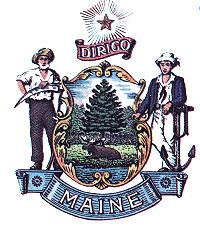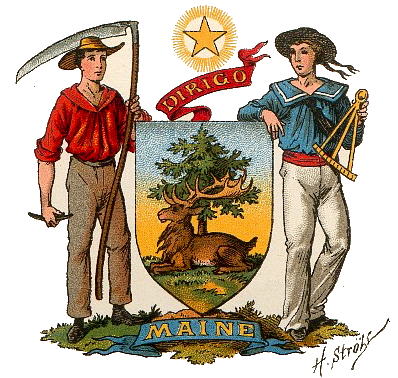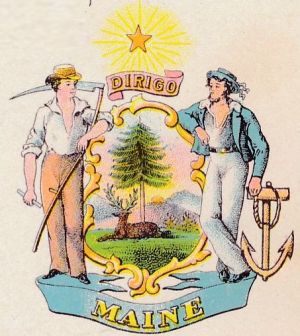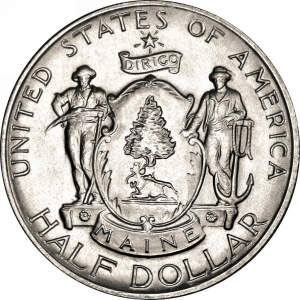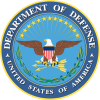Maine (state)
MAINE
Official blazon
Origin/meaning
The coat of arms of Maine was adopted by a law of June 9, 1820, three months after Maine's admission to statehood. The law described the arms as "A Shield, argent, charged with a Pine Tree, a Moose-Deer, at the foot of it, recumbent. Supporters; on dexter side, an Husbandman, resting on a scythe; on sinister side, a Seaman, resting on an anchor. In the foreground, representing sea & land, & under the Shield, the name of the State, in large Roman capitals, to wit MAINE. The whole surmounted by a Crest, the North Star. The Motto, in small Roman capitals, in a label interposed between the Shield & Crest, viz. DIRIGO."
The explanation of the design identifies the "moose-deer" as Cervus alces, a name now reserved for the European elk; the North American moose native to Maine and depicted on the arms is correctly Cervus canadensis. The moose symbolizes the unsettled lands of Maine as well as the spirit of independence and liberty.
The pine tree was described as "the staple of the commerce of Maine [and] the pride of her forests." The tree was specified as a mast pine, and describes it as having five needles in each cluster. This identifies it as an Eastern white pine (Pinus strobes), which commonly grows to 30 meters and can reach 50 meters and more. On account of its size, the trees were prized for use in making ships' masts, hence the name "mast pine." The evergreen ("semper viridis") nature of the pine was to symbolise the hopes of the citizens for the future of the state.
The crest, a single star, represents Maine as a state, alluding to the stars in the crest of the U.S. coat of arms a representing the collection of states. The North Star (Polaris, Alpha ursae minoris) is specified as appropriate for what was at the time the northernmost state. The motto, "Dirigo," which translates as "I direct" or "I guide" refers to the role of the North Star as the mariner's guide, implying a similar role for the state within the Union.
| 19th century image without the sea in the front |
The supporters symbolize agriculture (dexter) and commerce and fisheries (sinister).
The website of the Maine secretary of state points out that there have been many variations in the way the emblem on the seal has been portrayed, but also notes that "all the variations [were] based on the language above." This includes the difference between Bertha Smouse's original sketch and the current rendition. On the other hand, it is worth pointing out that the current version of the arms, fixed by the legislature in 1919, does not conform to the blazon, in that the field of the shield is shown as a landscape with blue sky, not white (argent) as stipulated in the law. In addition, it would appear from the original sketch that the design committee intended the "sea & land" prescribed for the "foreground" to form a compartment upon which the farmer, sailor, and shield would stand, not to be shown on the shield itself. Given the ambiguous and un-heraldic phrasing, however, this variation is not surprising.
| The arms in a 1902 booklet |
The arms on a memorial coin (source:eBay) |
US heraldry portal
This page is part of the US heraldry portal |
Heraldry of the World |
|
US heraldry:
|
Ecclesiastical Heraldry of the USA:
Military Heraldry: |
Contact and Support
Partners:
Your logo here ?
Contact us
© since 1995, Heraldry of the World, Ralf Hartemink 
Index of the site
Literature Information leaflet issued by the State of Maine, Ströhl, 1890; Background by Joe McMillan.
